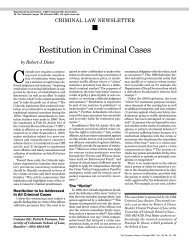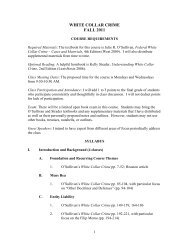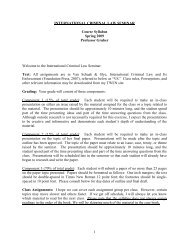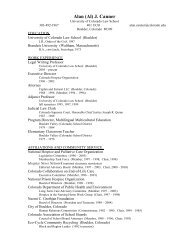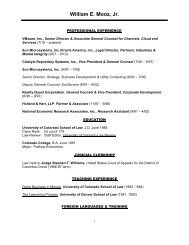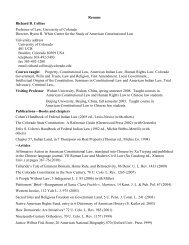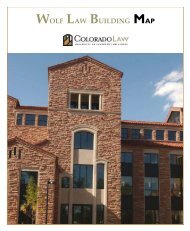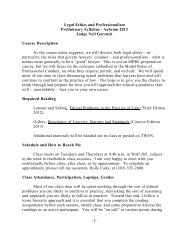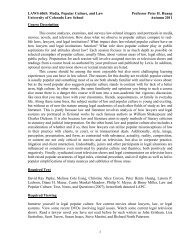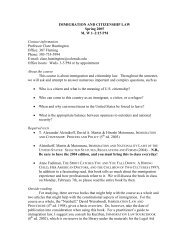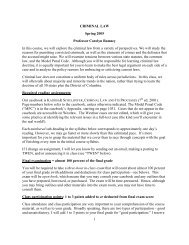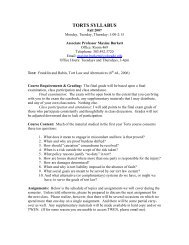Emergency Action Plan - Colorado Law
Emergency Action Plan - Colorado Law
Emergency Action Plan - Colorado Law
You also want an ePaper? Increase the reach of your titles
YUMPU automatically turns print PDFs into web optimized ePapers that Google loves.
<strong>Emergency</strong> <strong>Action</strong> <strong>Plan</strong>University of <strong>Colorado</strong> <strong>Law</strong> SchoolWolf <strong>Law</strong> Building
Table of ContentsPurpose ..................................................................................................................................................... 1<strong>Emergency</strong> Response Team...................................................................................................................... 2Organization ......................................................................................................................................... 2Primary Responsibilities....................................................................................................................... 2Team Responsibilities....................................................................................................................... 2Individual Team Member Responsibilities....................................................................................... 4<strong>Emergency</strong> Control Center ....................................................................................................................... 5Communications................................................................................................................................... 5<strong>Emergency</strong> Alarms and <strong>Emergency</strong> Response Team <strong>Action</strong>s ................................................................. 6Bomb Threat ......................................................................................................................................... 6Earthquake ............................................................................................................................................ 7Fire Detection/Suppression System...................................................................................................... 7Tornado................................................................................................................................................. 7Hazardous Chemical Spill .................................................................................................................... 8Riot or Public Disturbance.................................................................................................................... 8Fire Prevention and Workplace Hazards ................................................................................................ 10Appendix A – Faculty and staff <strong>Emergency</strong> Procedures........................................................................ 12Bomb Threat ....................................................................................................................................... 13Earthquake .......................................................................................................................................... 15Evacuation .......................................................................................................................................... 17Fire...................................................................................................................................................... 19Hazardous Chemical Spill .................................................................................................................. 20Medical <strong>Emergency</strong>............................................................................................................................ 21Riots or Public Disturbances .............................................................................................................. 22Tornado............................................................................................................................................... 23Appendix B - <strong>Emergency</strong> Telephone Listing ......................................................................................... 24Appendix C - <strong>Emergency</strong> Equipment and Supplies ............................................................................... 25Page<strong>Emergency</strong> <strong>Action</strong> <strong>Plan</strong>Page i
8. Annually review the action plan and revise as necessary.9. Train all faculty and staff in their duties under this plan.10. Ensure that key personnel know the location of the primary (Dean’s Suite) and alternate(Admissions Office) <strong>Emergency</strong> Control Center.11. Designate a faculty or staff member who will monitor local broadcast stations for weatherbulletins whenever a "watch" condition is declared for the local area.12. <strong>Plan</strong> training exercises to test evacuation plans.13. Ensure that all emergency equipment is maintained and available. This includesidentifying the location where the emergency equipment is stored.14. Ensure that emergency evacuation route maps are posted and clearly visible at all exits.15. Ensure that posters are placed throughout the building at appropriate locations designatingthe Floor Wardens.16. Ensure that signs are clearly visible to identify the location of safety equipment (e.g. fireextinguishers).17. Ensure that emergency telephone numbers are posted on the bulletin board and in otherconspicuous locations.Following the occurrence of an incident the <strong>Emergency</strong> Response Team will:1. Assess the nature and extent of the emergency.2. Assume control of all emergency actions.3. Assign tasks to faculty and staff to carry out specific actions that may be deemedappropriate and necessary.4. Order evacuation if deemed necessary.5. Take any other action necessary to protect the safety of all faculty, staff, students, andvisitors.<strong>Emergency</strong> <strong>Action</strong> <strong>Plan</strong> Page 3
Individual Team Member ResponsibilitiesDirector of Operations1. Serve as the permanent Team Leader for the <strong>Emergency</strong> Response Team.2. Establish a working relationship with campus and local authorities that may respond to anincident at our building.3. Serve as the primary interface with campus and local authorities responding to an incidentat our building.4. Coordinate an assessment of the incident to determine any damage that our building mayhave sustained as a result of an incident and/or how long authorities estimate we will beunable to enter or use our building.5. Ensure that the <strong>Emergency</strong> <strong>Action</strong> <strong>Plan</strong> is maintained.6. Determine if and when the Business Continuity <strong>Plan</strong> is to be implemented.7. Incorporate evacuation routes, emergency procedures and emergency telephone numbersinto the <strong>Emergency</strong> Quick Reference Guide.8. Brief all new faculty and staff on the <strong>Emergency</strong> <strong>Action</strong> <strong>Plan</strong> and their responsibilities in anemergency.Building Proctor1. Serve as the permanent Alternate Team Leader for the <strong>Emergency</strong> Response Team.2. Is prepared to assume the duties of the Team Leader in the event the Team Leader is absentwhen the incident occurs or is incapacitated by the event.3. Coordinate training for faculty and staff designated to utilize fire extinguishers.4. Coordinate emergency response training for all faculty and staff.5. Coordinate specialized training for designated faculty and staff in CPR and First Aid.6. Coordinate assistance and medical care for faculty, staff, and students that may have beeninjured as a result of the incident.<strong>Emergency</strong> Response Team Members (IT Manager, Dean’s Suite Receptionist)1. Be familiar with the contents of the plan and be prepared to act as the <strong>Emergency</strong> TeamLeader should the Director of Operations and the Building Proctor be absent when an eventoccurs.2. Be familiar with the contents of the plan and be prepared to assist the <strong>Emergency</strong> TeamLeader following the occurrence of an event.<strong>Emergency</strong> <strong>Action</strong> <strong>Plan</strong> Page 4
<strong>Emergency</strong> Control CenterThe <strong>Emergency</strong> Response Team will operate from the Dean’s Suite within the building unless or untilthe incident requires evacuation of the building. When an evacuation occurs the team will operatefrom their designated assembly point(s) outside the building.In the event of a hazardous chemical spill that results in authorities directing a building evacuation orthe <strong>Emergency</strong> Response Team determining that evacuation of the building is appropriate, the<strong>Emergency</strong> Response Team may designate an assembly area for the team and for all faculty, staff,students, and visitors evacuating the facility. The locations to be used for assembly areas will beannounced when the evacuation is ordered – possibilities: west (Lot 470); east (Lot 402).CommunicationsThe <strong>Law</strong> School will provide each member of the <strong>Emergency</strong> Response Team with a cellulartelephone and a radio telephone (may be one unit). This equipment is to be kept in working conditionat all times and team members are expected to have this equipment accessible to them at all times.Each team member's cellular telephone will be preprogrammed with the cellular telephone numbers(identification codes for radio transmission) of the other team members. The cellular telephonenumbers (identification codes for radio transmission) of other key organizational members may also bepreprogrammed into the telephones.<strong>Emergency</strong> <strong>Action</strong> <strong>Plan</strong> Page 5
<strong>Emergency</strong> Alarms and <strong>Emergency</strong> Response Team <strong>Action</strong>sNotification of an emergency may come from any one or more of the following sources:• Automated alarm from the fire detection/suppression system.• Commercial radio or television.• Messenger.• Telephone call from a faculty, staff, or student within the building or from local authorities.• Police.• Civil defense system.Any person receiving notification of a possible disaster or other emergency should immediately notifythe Dean’s Office. If the emergency is a fire, the faculty, staff, or student discovering the fire will alsoactivate the fire alarm.Bomb ThreatAlarm: Fire alarm … long, intermittent audio signal and flashing strobe lightsMost bomb threats will be received by a telephone call to a faculty or staff member in the building.Other possible modes of notification, however, do include written correspondence sent by mail ormessenger or fax as well as telephone calls to outside parties such as local law enforcement or themedia. In all cases, notification should be provided immediately to the supervisor of any faculty orstaff receiving a bomb threat notification and to the Dean’s Office. This notification should include acompleted Bomb Threat Checklist if the person notified is a faculty or staff member.Upon receipt of notification of a Bomb Threat:1. The <strong>Emergency</strong> Response Team will assemble in the primary <strong>Emergency</strong> Control Center(Dean’s Office).2. Immediate notification will be provided to local law enforcement and the Fire Department.3. If the notification indicates that there is sufficient time to conduct a visual search of thebuilding without endangering the safety of faculty, staff, students and visitors, all facultyand staff will be notified of the bomb threat by the <strong>Emergency</strong> Response Team andrequested to conduct a search.4. The <strong>Emergency</strong> Response Team will determine when it is appropriate to order anevacuation of the building. At such time they will activate the evacuation alarm.<strong>Emergency</strong> <strong>Action</strong> <strong>Plan</strong> Page 6
EarthquakeAlarm: The initial notification of an earthquake will be when everyone in the building feels thebuilding rolling or shaking. Following pre-planned emergency instructions they will take cover andremain in the facility.Immediately following an earthquake the <strong>Emergency</strong> Response Team will assemble in the primary<strong>Emergency</strong> Control Center (Dean’s Office).1. Designate a faculty or staff member to monitor local broadcast stations using a portableradio to determine any orders being issued by local authorities and the severity of the event.2. Determine if any individuals were injured by the event and insure that First Aid is renderedwhen appropriate.3. The <strong>Emergency</strong> Response Team will attempt to obtain ambulance service for any faculty,staff, students, or visitors requiring medical treatment beyond basic First Aid.4. Assess the damage sustained by the building. This includes checking for possible fires, gasleaks, the loss of power and basic services such as water. If gas leaks are found,immediately turn off gas service at the main control. The same action should be taken ifwater leaks are discovered.5. Contact the Fire Department if any serious fires are found.6. Contact the utility company if any gas lines, electrical lines or water lines are broken.7. If the earthquake was a major earthquake and the building has been damaged or reportsindicate that severe damage has been sustained by the public infrastructure, the <strong>Emergency</strong>Response Team Leader will determine whether or not it is appropriate to activate theBusiness Continuity <strong>Plan</strong>.Fire Detection/Suppression SystemAlarm: Long, intermittent audio signal accompanied by flashing strobe lightsFaculty, staff, students, and visitors will evacuate the building to their designated assembly areaslocated in the parking lots at the west (Lot 470) and east (Lot 402) sides of the building. The<strong>Emergency</strong> Response Team will meet at their designated assembly point (west side parking lot … Lot470) outside the facility and initiate action as described by their primary responsibilities.TornadoAlarm: Determination will be made concerning the type and delivery of this alarm since evacuation isnot the appropriate initial response.When the Director of Operations becomes aware that a "Tornado Watch" has been declared by theNational Weather Service, a faculty or staff member will be assigned to monitor local stations for<strong>Emergency</strong> <strong>Action</strong> <strong>Plan</strong> Page 7
additional weather bulletins. In addition, faculty and staff members will be advised to keep a close eyeon the weather for possible funnel clouds.Should the "Tornado Watch" be upgraded to a "Warning" condition or should a funnel cloud beobserved, the <strong>Emergency</strong> Response Team will be notified immediately. The <strong>Emergency</strong> ResponseTeam will the sound the emergency alarm for all faculty, staff, students, and visitors to move to thedesignated safe assembly areas in the building (i.e. elevator lobby areas, restrooms, courtrooms,windowless areas).If a tornado should impact the physical facility, the <strong>Emergency</strong> Response Team will initiate actions to:1. Render first aid to any faculty, staff, students, or visitors that may have been injured.2. Summon ambulances for any faculty, staff, students, or visitors that may have sufferedmore than minor injuries.3. Determine the extent of damage sustained by the building.4. If the damage is severe, the <strong>Emergency</strong> Response Team Leader will determine whether ornot it is appropriate to activate the Business Continuity <strong>Plan</strong>.Hazardous Chemical SpillAlarm: Determination will be made concerning the type and delivery of this alarm since evacuationmay not be the appropriate initial response.Initial notification of a hazardous chemical spill will probably come from local officials who have beencalled to the scene to assess the situation and clean up the spill. The <strong>Emergency</strong> Response Team willact in strict accordance with instructions provided by these officials.If local officials order an evacuation of the area the <strong>Emergency</strong> Response Team will announce theevacuation and the assembly points to which associates should proceed upon departing the facility.They will also provide any other special instructions they may have received from the local officials.The <strong>Emergency</strong> Response Team will attempt to determine how long officials estimate the facility willbe closed for clean up of the spill. This information will serve as the basis for determining whether ornot the response activities in the Business Continuity <strong>Plan</strong> are to be activated.Riot or Public DisturbanceAlarm: Determination will be made concerning the type and delivery of this alarm since evacuationmay not be the appropriate initial response.Riot or public disturbance will probably first be observed by those faculty and staff with a view outsidethe facility. These faculty and staff will immediately notify the Dean’s Office of the situation. TheDirector of Operations will determine if the activity occurring warrants activation of this plan. If theplan is activated, the <strong>Emergency</strong> Response Team will assemble in the primary <strong>Emergency</strong> ControlCenter (Dean’s Office).<strong>Emergency</strong> <strong>Action</strong> <strong>Plan</strong> Page 8
1. Secure all entrances and exits from the building.2. Close windows and, if they are equipped with drapes, window shades or other devices toinhibit observation, move the drapes, shades or other devices to the closed position.3. The <strong>Emergency</strong> Response Team will notify local law enforcement and coordinate actions tobe taken by faculty and staff in the building with these officials.4. The <strong>Emergency</strong> Response Team will notify all faculty, staff, and students of the situationand the actions taken and being taken.5. Faculty, staff, and students will distance themselves from windows.<strong>Emergency</strong> <strong>Action</strong> <strong>Plan</strong> Page 9
Fire Prevention and Workplace HazardsIt is the responsibility of all faculty, staff, and students to prevent any type of fire in the building.Common sense, strict adherence to University policies and safety and safe work policies greatly reducethe risk of fire. Policies of particular importance are:1. Smoking. This facility is a designated No Smoking facility.2. Flammable Materials. All flammable materials are to be stored in controlled areasestablished for that purpose.3. Housekeeping. The housekeeping policy provides guidelines to ensure that the buildingand all work areas are kept clean and free from clutter.The Director of Operations will take action to:1. Work with FacMan to ensure that adequate electrical power is available before introducingnew electrical equipment into the work place.2. Ensure that all faculty and staff members observe good housekeeping practices at all times.This includes:• Discarding waste materials into the proper containers.• Keeping all aisles and exits clear at all times.• Keeping all storage and file areas neat and orderly.3. Ensure that any cleaning materials used by faculty and staff members in their areas to cleantheir desks or equipment are used in strict accordance with the manufacturers directions andare properly stored when not in use. Often these materials contain highly flammablesubstances and their improper use could result in a fire.4. Maintain a heightened degree of vigilance when outside contractors or maintenancepersonnel are working in your work area. Fires and other emergencies often result from thecareless acts of such personnel in accomplishing their work.The Director of Operations, along with FacMan, is responsible for ensuring that:• The fire alarm and suppression system is inspected and serviced in accordance with themanufacturers maintenance schedules.• Any required inspections of handheld fire extinguishers is performed in a timely mannerand properly recorded on the inspection record attached to the extinguisher.• Required maintenance of the heating and cooling systems are scheduled and completed asspecified in the manufacturers maintenance schedules.• The areas immediately surrounding all heating systems are kept clean and free from anycombustible materials not required for their operation.<strong>Emergency</strong> <strong>Action</strong> <strong>Plan</strong> Page 10
• When any of the fire suppression systems are deactivated for maintenance, trained facultyor staff members are standing fire watch to respond quickly to any fire emergency in thenormally protected area.• Appropriate warning signs are posted in those areas protected by a gas fire suppressionsystems that may pose a hazard to health of associates (e.g. CO2, Halon 1411).• All mechanical areas are kept free and clear of storage items, file cabinets, and combustiblematerials, etc.Director of Operations will also coordinate with FacMan and local fire officials for periodic fire safetyinspections to be conducted. Any deficiencies found during such inspections will be remedied asquickly as possible.Director of Operations will conduct periodic assessments of the threats and risks present in thebuilding and the immediate areas outside the building. Such assessments should be conducted at leastonce every 24 months.<strong>Emergency</strong> <strong>Action</strong> <strong>Plan</strong> Page 11
Appendix A - Associate <strong>Emergency</strong> Procedures(For additional information and guidance, please familiarize yourself withand consult the “<strong>Emergency</strong> Quick Reference Guide.”)<strong>Emergency</strong> <strong>Action</strong> <strong>Plan</strong> Page 12
Bomb ThreatINSTRUCTIONS:If you receive a bomb threat, get as much information as possible from the caller. Listen while he orshe talks and then make certain observations (i.e., was the caller male or female, what time was it, longdistance or local, voice characteristics of the caller, background noise such as clock chime, passingtrain, airport, etc.). Immediately write all information down on the Bomb Threat Checklist (seeaccompanying copy of checklist).Bomb Threats Must Be ReportedIf you receive a bomb threat, immediately call 9-1-1 and inform emergency authorities.Notify the Dean’s Office (Director of Operations or the Building Proctor). The person you notify willinitiate the appropriate emergency actions.Employee Search <strong>Plan</strong>Immediate arbitrary evacuation upon initial receipt of a bomb threat is not recommended unless thecaller indicates that the time the bomb detonation is imminent. The safest and most expedient way ofhandling a bomb threat is the Employee Search <strong>Plan</strong>.Examine your office space for strange or suspicious items. DO NOT TOUCH any suspicious items.Some bombs are set to detonate upon movement. Report any strange or suspicious items to theDirectory of Operations or the Building Proctor immediately. Remember, no outsider knows your areaas well as you do. What appears commonplace to the outsider may be out of place to you.Building ProceduresThe Director of Operations will activate the <strong>Emergency</strong> Response Team when advised of a bombthreat. The <strong>Emergency</strong> Response Team will notify local law enforcement and the Fire department.The <strong>Emergency</strong> Response Team will notify supervisors/managers of the threat and if time permits willinitiate the Employee Search <strong>Plan</strong>.The <strong>Emergency</strong> Response Team is responsible for determining when evacuation is appropriate andwill initiate the evacuation alarm at that time.<strong>Emergency</strong> <strong>Action</strong> <strong>Plan</strong> Page 13
Bomb Threat ChecklistQUESTIONS TO ASK:1. When is bomb going to explode?2. Where is it right now?3. What does it look like?4. What kind of bomb is it?5. What will cause it to explode?6. Did you place the bomb?7. Why?8. What is your name?9. What is your phone number?10. What is your address?Sex of Caller ___ Age___ Accent? _________ Length of CallDid Caller appear familiar with the facility by his or her description of the bomb location?CALLERS VOICE:_____ Calm _____ Laughing _____ Lisp_____ Angry _____ Crying _____ Raspy_____ Excited _____ Normal _____ Deep_____ Slow _____ Distinct _____ Clearing_____ Rapid _____ Slurred _____ Crackling_____ Soft _____ Nasal _____ Disguised_____ Loud _____ Stutter _____ FamiliarBACKGROUND SOUNDS:___ Street Noises ___ Motor ___ Factory ___ Local _____Machinery___ Voices ___ Office ___ Animal ___ Long___ Noises Distance ___ PA System ___ Machines ___ Clear ___ Booth___ Music ___ Static ___ Other___ House NoisesTHREAT LANGUAGE:___ Well Spoken ___ Foul ___ Incoherent ___ Message(educated)Read by___ Irrational ___ TapedcallerREMARKS: ___________________________________________________________________________________________________________REPORT CALL IMMEDIATELY TO 911Date _______________ Time _________ Phone Number ___________Name _________________________ Position_____________________Company ____________________________________Suite #_________<strong>Emergency</strong> <strong>Action</strong> <strong>Plan</strong> Page 14
EarthquakeEarthquakes come without warning and are generally of short duration. The <strong>Law</strong> School building wasdesigned to meet the highest earthquake specifications. This should minimize damage and the potentialfor injuries. In the event of an earthquake:• Remain calm• Get under a sturdy object (such as a desk or table) away from glass.• Cover your head.• If you are outside, stay clear of falling glass.• In the event of a fire resulting from an earthquake, follow the company emergencyprocedures for a fire.Please see the accompanying illustrations for proper protection of you head and body whileunderneath a table or standing in a doorframe.Building ServicesMany of the normal services and/or emergency services may be interrupted because of the scope of anearthquake.Special InstructionsFollowing a major earthquake the <strong>Emergency</strong> <strong>Action</strong> <strong>Plan</strong> will automatically be implemented. The<strong>Emergency</strong> Response Team will determine the appropriate action to be taken by our faculty, staff, andstudents and advise them of these actions. The team will also attempt to determine the local damagethat has resulted from the earthquake and pass this information along to all associates.Faculty and staff should not leave their work areas until advised to do so by the <strong>Emergency</strong> ResponseTeam. Adequate food, water and sanitary supplies are available for all personnel for up to 3 businessdays, should local authorities request that you remain on-site.The Director of Operations, Building Proctor and other qualified associates will check to determine ifany of our require first aid. The <strong>Emergency</strong> Response Team will coordinate first aid assistance and, ifnecessary, will summon additional medical assistance for injuries that require treatment beyond basicfirst aid.Should any detect the odor of gas or observe a water leak, they should immediately notify the<strong>Emergency</strong> Response Team.<strong>Emergency</strong> <strong>Action</strong> <strong>Plan</strong> Page 15
<strong>Emergency</strong> <strong>Action</strong> <strong>Plan</strong> Page 16
EvacuationEvacuation routes have been established for all faculty, staff, students, and visitors to follow in theevent an emergency evacuation of the building is necessary. A map showing these routes is on thefollowing page. Additionally, copies of the map are posted by all exits.Immediately following an emergency evacuation from the building, all personnel and their visitorsshould proceed to their designated assembly point on the west side of the building (Lot 470) and theeast side of the building (Lot 402). The location of each assembly point is also shown on the map.Evacuation Assembly AreaIt is important that management knows that you have safely exited the building when an emergencyrequires an evacuation of the facility. Please check with the Director of Operations or the BuildingProctor immediately upon exiting the building.A building evacuation may not result in the end of your workday. The <strong>Emergency</strong> Response Teamwill assess the situation and inform you of action to be taken. To ensure that you are informed ofdecisions made by the <strong>Emergency</strong> Response Team insure that they know of your location until you areadvised of any decision made by the <strong>Emergency</strong> Response Team.Hot Doors• Before opening a door, touch it near the top to see if it is hot.A fire on the other side could blast through the smallest opening with tremendous force andheat.DO NOT OPEN A HOT DOOR.• When an evacuation alarm (e.g. fire alarm) sounds or the <strong>Emergency</strong> Response Teamorders an immediate evacuation, all faculty, staff, students, and visitors are toimmediately evacuate the building.<strong>Emergency</strong> <strong>Action</strong> <strong>Plan</strong> Page 17
Map showing evacuation routes from the building is being prepared and will be provided by FacMan.<strong>Emergency</strong> <strong>Action</strong> <strong>Plan</strong> Page 18
Hazardous Chemical SpillFaculty and staff should ensure that all outside doors, windows and vents are closed.Faculty and staff should remain in their work areas until directed to evacuate the building by the<strong>Emergency</strong> Response Team.Faculty and staff should assemble at locations designated by the <strong>Emergency</strong> Management Team whenthey announced the evacuation.Faculty and staff outside of the building should leave the immediate area and contact their supervisorsby telephone as soon as possible to advise them of their location.<strong>Emergency</strong> <strong>Action</strong> <strong>Plan</strong> Page 20
Medical <strong>Emergency</strong>CPR/First AidKey personnel have been certified by the American Red Cross to administer CPR and First Aid.Accident or sudden illness may cause an emergency that necessitates immediate first aid andsubsequent medical attention. The Fire Department <strong>Emergency</strong> Services is equipped to handlebreathing and other lifesaving problems, and have trained resuscitation teams.To save valuable time in a serious emergency dial 9-1-1 immediately. Determine, if possible, thenature of the illness from the patient, what medication, if any, has been taken, and the doctor andhospital of the patient’s choice.First Aid KitsAn extensive First Aid Kit is located in the Dean’s Suite on the 3 rd floor. Minor kits are located inAdmissions and Clinics on the First Floor; Library Circulation Desk and Café servery on the 2 nd floor;Career Services on the 3 rd floor; and, Faculty Assistants on the 4 th floor.Handicapped PersonnelHandicapped personnel should be familiar with emergency procedures for floor evacuation, use ofexits and any special arrangements necessary for their safe exit from the building. Please note:pregnant women are also considered handicapped.<strong>Emergency</strong> <strong>Action</strong> <strong>Plan</strong> Page 21
Riots or Public DisturbancesOutside the BuildingIf a general disturbance occurs outside of the building and you do not observe police on the scenenotify the Campus Police Department at 9-1-1. At the same time, notify the Dean’s Office (2-8047).Faculty, staff, and students in the building should remain in their immediate work/classroom areasunless directed to do so by the <strong>Emergency</strong> Response Team.Inside the BuildingIf participants enter the building, be courteous and do not provoke an incident. If necessary, call theCampus Police Department at 9-1-1. At the same time, notify the Dean’s Office (2-8047).Faculty and staff in other areas of the building should secure their work area to limit the ability of theparticipants to enter. Faculty and staff should not attempt to leave their work area unless advised to doso by the <strong>Emergency</strong> Response Team through their supervisor or by general announcement.General Precautions• Remain calm.• Do not become a spectator.• If outside of your office, leave or avoid the area to prevent possible injury.(As soon as possible, notify the Dean’s Office (2-8047) by telephone of your location.)• Close all drapes.• Avoid window areas.• Do not argue or enter into debate with participants.Director of OperationsThe Director of Operations will activate the <strong>Emergency</strong> <strong>Action</strong> <strong>Plan</strong> and initiate coordination withcampus and local authorities. Appropriate action to protect our faculty, staff, students, and visitors thatare on-site at the time of the disturbance will be initiated by the <strong>Emergency</strong> <strong>Action</strong> Team incoordination with or at the direction of the campus and local authorities managing the incident.<strong>Emergency</strong> <strong>Action</strong> <strong>Plan</strong> Page 22
TornadoFaculty, staff, students, and visitors move from their work areas to designated safe assembly areaswithin the building.The Director of Operations or the Building Proctor will ensure that supervisors account for all faculty,staff, students, and visitors.Faculty, staff, and students should remain in the designated safe assembly areas until the tornado haspassed or the tornado warning has been rescinded.<strong>Emergency</strong> <strong>Action</strong> <strong>Plan</strong> Page 23
Appendix B - <strong>Emergency</strong> Telephone ListingEMERGENCY NUMBERS:Fire 911Police 911Ambulance 911POLICE DEPARTMENT Campus: 303-492-6666Boulder: 303-441-3333COUNTY SHERIFF 303-441-4444STATE POLICE 303-469-1966FBI 303-629-7171POISON INFORMATION 1-800-222-1222ELECTRIC UTILITY FacMan: 303-492-5522GAS UTILITY FacMan: 303-492-5522WATER DEPARTMENT FacMan: 303-492-5522EMERGENCY CONTROL CENTERPrimary: Dean’s Office 303-492-8047Alternate: Admissions 303-492-3825<strong>Emergency</strong> <strong>Action</strong> <strong>Plan</strong> Page 24
Appendix C - <strong>Emergency</strong> Equipment and SuppliesList all emergency equipment, except for fire extinguishers and first aid kits, and supplies stored andmaintained by the <strong>Law</strong> School. The listing should identify the equipment or supplies, quantities andlocation where it is stored.<strong>Emergency</strong> <strong>Action</strong> <strong>Plan</strong> Page 25




